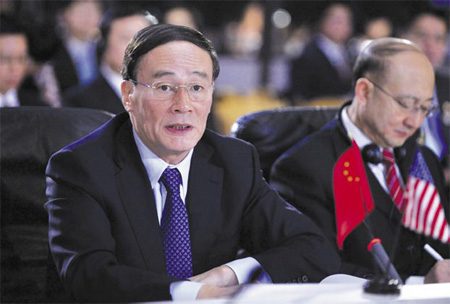China-US
China rebukes US export curbs
Updated: 2010-12-16 11:07
By Tan Yingzi (China Daily)
|
|
WASHINGTON - China continued to add pressure on the United States to reform its export controls on high-tech products, a key move Chinese officials say will ease the massive trade deficit between the two nations.
The latest public debate over the deficit occurred at the two-day China-US Joint Commission on Commerce and Trade in Washington, a day after China's Ministry of Commerce blamed the deficit on the US' export curbs.
"China is highly concerned and has high hopes for the Obama administration to reform its export control regime," said Commerce Minister Chen Deming at a briefing.
China claims that easing the controls will also help the US lower its high unemployment rate. The ministry said it will commit to boost imports to help balance trade next year.
At the meeting, China and the US promised more open and fair access for US companies to the Chinese market and made progress to cooperate on smart grid and telecommunication development.
More major breakthroughs in bilateral trade will be expected during President Hu Jintao's visit to the US next month.
In the meeting with US Secretary of Commerce Gary Locke, US Trade Representative Ron Kirk, US Secretary of Agriculture Tom Vilsack and Chinese Vice-Premier Wang Qishan, the two sides also agreed to explore the possibilities of establishing a cooperation framework on intellectual property rights.
Recent reform of high-tech controls by Washington has thus far disappointed China. The US' new policy excluded China from a list of 164 countries that were granted favorable trade conditions.
Earlier this week, two US senators said they are seeking legislation to place high duties on Chinese exporters in response to what they call China's "undervalued currency".
It is estimated that only 7 percent of China's high-tech imports, in terms of value, are from the US.
"How to address the trade imbalance depends on whether the US would like to loosen restrictions on high-tech exports to China, rather than concentrate on yuan appreciation. If there were no such controls, China's imports from the US would rise sharply and the US trade deficit would narrow," said Yao Zhizhong, senior researcher at the Chinese Academy of Social Sciences.
There was more agreement on other topics at the meeting. On indigenous innovation, China agreed not to discriminate based on the origin of intellectual property or to use discriminatory criteria to select industrial equipment.
"I am pleased as well with China's pledge to adhere to openness, non-discrimination, and transparency in its smart grid market, and to cooperate with the United States on smart grid standards, creating more opportunities in a market that is estimated to be worth $600 billion," Locke said. "Similarly, China's commitment on technology neutrality for 3G and future technologies will ensure market access for American businesses to one of the world's largest telecommunications markets."
In addition, China reaffirmed it will resume the import of US beef.
Due to the discovery of the mad cow disease in the US cattle herd in 2003, a number of countries, including China, closed their markets to US beef at that time.
US-China Business Council (USCBC) President John Frisbie saw progress achieved by the trade meeting and said trade tension should be solved through these means, not through sanctions and legislation.
"We are pleased that there was movement on some of the key concerns raised by USCBC and our member companies," Frisbie said in a statement. "It is critically important to show progress in advance of the expected state visit of President Hu Jintao in January."
According to Chinese government statistics, from January to November, China-US trade reached $346 billion, surpassing 2008 figures. The two countries are now each other's second largest trading partner.
China is the third largest export market for the US. The cumulative US direct investment in China has exceeded $60 billion, while Chinese investments in the US has been growing annually at 78 percent over the past three years.
Ding Qingfen and Bao Chang contributed to this story.
China Daily
Specials

President Hu visits the US
President Hu Jintao is on a state visit to the US from Jan 18 to 21.

Ancient life
The discovery of the fossile of a female pterosaur nicknamed as Mrs T and her un-laid egg are shedding new light on ancient mysteries.

Economic Figures
China's GDP growth jumped 10.3 percent year-on-year in 2010, boosted by a faster-than-expected 9.8 percent expansion in the fourth quarter.
